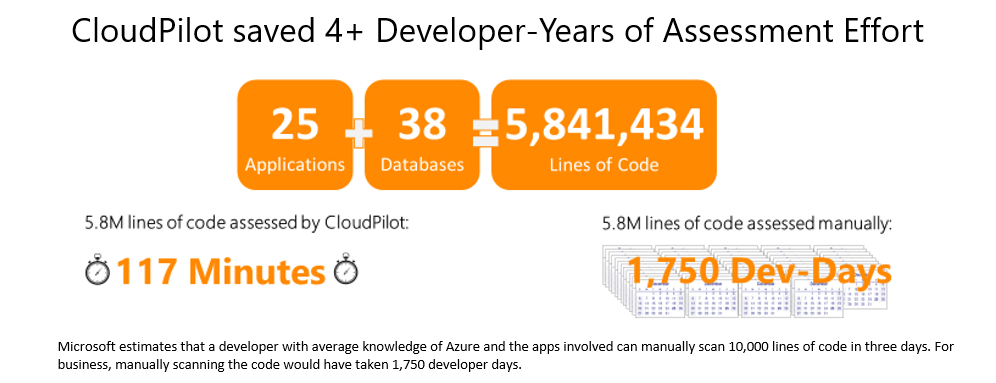As we proceed into the second decade of the cloud era, the question businesses increasingly face is not whether to move key workloads to the cloud; but which key workloads to move to the cloud and how to do that without risk. Many organizations have previously taken the easier route by leaving mission-critical workloads untouched due to concerns over downtime, risk, and reliability. The time has come where addressing these mission-critical workloads is now a step that many must take to move enterprise IT forward.
Let’s look at an example of a successful cloud migration project that safely and effectively transitioned mission-critical workloads to Microsoft Azure.
A global insurance company realizes 69% cost savings by moving to Azure
A Fortune 500 global insurance company was looking to move mission-critical workloads to the cloud. The company operated a major datacenter that supports all their operations across an entire continent, and wanted to understand their options, the level of effort, and the potential cost savings of moving the datacenter, applications, and databases to Azure. To do this, the company initiated an engagement to assess their infrastructure for modernization.
The project commenced in early January, beginning with three weeks of data collection – a critical step that gathers vital information about infrastructure and workload configuration and utilization. The heavy lifting began in early February with an analysis of the discovery data and an assessment of the datacenter infrastructure. Time was then spent conferring with project team members on the analysis, data sources, and assumptions, and making adjustments to provide the most accurate estimates and recommendations. Results were presented to company leadership at the end of February.
- Cloud economics – The assessment of the datacenter revealed IT infrastructure of over 500 Windows VMs and more than 300 Linux VMs. Multiple cloud options were identified, but focus was quickly directed on an opportunity to reduce costs by moving the datacenter to Azure and taking advantage of three-year Azure Reserved VM Instances, Azure Hybrid Benefit, and SQL Managed Instance consolidation. Additional significant savings were identified by migrating Oracle to PostgreSQL on Azure. The year one total cost of ownership (TCO) analysis projected a reduction in cost by 69%.
- App and data optimization – In addition to the infrastructure, 25 key custom-built applications and 38 associated databases were assessed. Static code analysis of each application highlighted the code changes required, the reason for the change, the code block, line number and file path, the recommended changes including sample code, the estimated level of effort, and the impact of the changes. The databases included Oracle and SQL Server with the assessment suggesting migrating the preponderance to SQL Azure.
The Azure cost estimates, and depth of app and database analysis was compelling enough that the company agreed to move their entire datacenter to Azure by the early of 2022. They also decided to modernize and migrate the first mission-critical app as a pilot for future modernization. Using detailed guidance, the app was remediated, and the SQL Server database was modernized to SQL Azure. The modernization and migration began in early March and was completed in just 22 days. This target project moved from assessment to running in Azure PaaS and SQL MI in just ten weeks.
Digital transformation: Oracle and Sybase to SQL Azure
Recognizing the value of its internal applications and wanting to explore migration options beyond the standard “lift and shift” to IaaS, the company sought to digitally transform its apps to PaaS and its Oracle databases to SQL Azure.
UnifyCloud’s CloudPilot was the tool of choice, scanning 5.8 million lines of custom-built internal application code, scripts, and stored procedures in just 117 minutes – 7,200 times faster than a manual assessment! Required changes were identified down to the line of code for a successful migration to Azure, including authoritative guidance and sample replacement code. Recommendations were provided for application migration to PaaS, VMs, and containers, as well as Oracle and Sybase database migration to SQL Azure.

Building on this success, the company has continued to modernize and migrate their workloads, apps and databases to Azure, saving almost $5 million dollars per year.
Scalable, repeatable migration and modernization to PaaS
UnifyCloud has spent the last ten years developing and perfecting repeatable solutions and scalable tools that can scan applications and databases in just minutes. Using automation solutions like those developed by UnifyCloud delivers analysis and results quickly and provides great value to businesses embarking on the cloud migration journey. This company is a prime example; progressing from assessment, to modernization, to migration to Azure in a very short time. Automation was key to accelerating and streamlining the process – 117 minutes to assess 5.8 million lines of code, 22 days to modernize a key application, 10 weeks from assessment to the cloud.
A company leader noted that UnifyCloud helped the company develop a solid plan for migration and modernization of business-critical apps and databases to Microsoft Azure by providing a roadmap on how to modernize apps to PaaS and Oracle databases to Azure SQL while significantly reducing expense.
Conclusion
Pressure is mounting to modernize mission-critical workloads to the cloud. Business leaders are demanding it and IT decision-makers are prioritizing it. The time for waiting is over as the “easy” migrations are already done. With greater need and fewer barriers to moving mission-critical workloads, the focus should be on a sound strategy, proper planning and automation that facilitates and accelerates the process and ensures risk and downtime are minimized or eliminated. Seize the opportunity to reap the many benefits of the cloud and get started by visiting UnifyCloud today. Learn more about how you can run business-critical applications on Azure by visiting Microsoft’s website or reading the blog.


